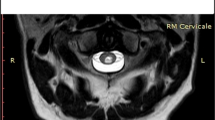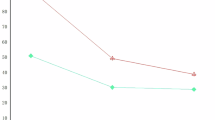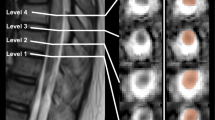Abstract
Study design
Animal study.
Objectives
To evaluate the efficacy of hyperbaric oxygen (HBO) therapy for spinal cord injury (SCI) in rats with different treatment course using diffusion tensor imaging (DTI).
Setting
Hospital in Fuzhou, China.
Methods
Fifty adult Sprague-Dawley rats were grouped as: (A) sham-operated group (n = 10); (B) SCI without HBO therapy group (n = 10); (C) SCI with HBO therapy for 2 weeks (SCI+HBO2W) group (n = 10); (D) SCI with HBO therapy for 4 weeks (SCI+HBO4W) group (n = 10); (E) SCI with HBO therapy for 6 weeks (SCI+HBO6W) group (n = 10). Basso Beattie Bresnahan (BBB) scores and diffusion tensor imaging parameters including fractional anisotropy (FA), mean diffusivity (MD), radial diffusion (RD), and axial diffusion (AD) values in the injury epicenter, as well as 2 mm rostral and caudal to the injury epicenter were collected and analyzed 6 weeks post-injury.
Results
Higher BBB score and FA values were found in the SCI+HBO4W group than in the SCI and SCI+HBO2W groups (all P < 0.05), whereas no significant differences of these metrics were observed between the SCI+HBO4W and SCI+HBO6W groups. MD and RD values of the SCI+HBO4W group were significantly lower than those of the SCI group (all P < 0.01). FA values were positively correlated with BBB scores. MD and RD values were negatively correlated with BBB scores.
Conclusion
DTI parameters, especially FA, could non-invasively and quantifiably evaluate the efficacy of HBO treatment for rats with SCI and 4 weeks may be the more appropriate treatment course.
Similar content being viewed by others
Log in or create a free account to read this content
Gain free access to this article, as well as selected content from this journal and more on nature.com
or
References
Jazayeri SB, Beygi S, Shokraneh F, Hagen EM, Rahimi-Movaghar V. Incidence of traumatic spinal cord injury worldwide: a systematic review. Eur Spine J. 2015;24:905–18.
Kwon BK, Tetzlaff W, Grauer JN, Beiner J, Vaccaro AR. Pathophysiology and pharmacologic treatment of acute spinal cord injury. Spine J. 2004;4:451–64.
Long Y, Liang F, Gao CJ, Li Z, Yang J. Hyperbaric oxygen therapy reduces apoptosis after spinal cord injury in rats. Int J Clin Exp Med. 2014;7:4073–81.
Tan J, Zhang F, Liang F, Wang Y, Li Z, Yang J, et al. Protective effects of hyperbaric oxygen treatment against spinal cord injury in rats via toll-like receptor 2/nuclear factor-κB signaling. Int J Clin Exp Pathol. 2014;7:1911–9.
Wang Y, Zhang S, Luo M, Li Y. Hyperbaric oxygen therapy improves local microenvironment after spinal cord injury. Neural Regen Res. 2014;9:2182–8.
Kang N, Hai Y, Yang J, Liang F, Gao CJ. Hyperbaric oxygen intervention reduces secondary spinal cord injury in rats via regulation of HMGB1/TLR4/NF-κB signaling pathway. Int J Clin Exp Pathol. 2015;8:1141–53.
Sun Y, Liu D, Su P, Lin F, Tang Q. Changes in autophagy in rats after spinal cord injury and the effect of hyperbaric oxygen on autophagy. Neurosci Lett. 2016;618:139–45.
Mhuircheartaigh NN, Kerr JM, Murray JG. MR imaging of traumatic spinal injuries. Semin Musculoskelet Radiol. 2006;10:293–307.
Loy DN, Kim JH, Xie M, Schmidt RE, Trinkaus K, Song S-K. Diffusion tensor imaging predicts hyperacute spinal cord injury severity. J Neurotrauma. 2007;24:979–90.
Kelley BJ, Harel NY, Kim CY, Papademetris X, Coman D, Wang X, et al. Diffusion tensor imaging as a predictor of locomotor function after experimental spinal cord injury and recovery. J Neurotrauma. 2014;31:1362–73.
Li XH, Li JB, He XJ, Wang F, Huang SL, Bai ZL. Timing of diffusion tensor imaging in the acute spinal cord injury of rats. Sci Rep. 2015;5:12639.
Patel SP, Smith TD, VanRooyen JL, Powell D, Cox DH, Sullivan PG, et al. Serial diffusion tensor imaging in vivo predicts long-term functional recovery and histopathology in rats following different severities of spinal cord injury. J Neurotrauma. 2016;33:917–28.
Sun W, Tan J, Li Z, Lu S, Li M, Kong C, et al. Evaluation of hyperbaric oxygen treatment in acute traumatic spinal cord injury in rats using diffusion tensor imaging. Aging Dis. 2018;9:391–400.
Budde MD, Xie M, Cross AH, Song SK. Axial diffusivity is the primary correlate of axonal injury in the experimental autoimmune encephalomyelitis spinal cord: a quantitative pixelwise analysis. J Neurosci. 2009;29:2805–13.
Janve VA, Zu Z, Yao SY, Li K, Zhang FL, Wilson KJ, et al. The radial diffusivity and magnetization transfer pool size ratio are sensitive markers for demyelination in a rat model of type III multiple sclerosis (MS) lesions. Neuroimage. 2013;74:298–305.
Basso DM, Beattie MS, Bresnahan JC. Graded histological and locomotor outcomes after spinal cord contusion using the NYU weight-drop device versus transection. Exp Neurol. 1996;139:244–56.
Falavigna A, Figueiro MP, Silva PGD, Conzatti LP, Rizkalla EB, Santos SCD, et al. Hyperbaric oxygen therapy after acute thoracic spinal cord injury: improvement of locomotor recovery in rats. Spine. 2018;43:E442–E7.
Li Y, Lucas-Osma AM, Black S, Bandet MV, Stephens MJ, Vavrek R, et al. Pericytes impair capillary blood flow and motor function after chronic spinal cord injury. Nat Med. 2017;23:733–41.
Patel NP, Huang JH. Hyperbaric oxygen therapy of spinal cord injury. Med Gas Res. 2017;7:133–43.
Beattie MS, Farooqui AA, Bresnahan JC. Review of current evidence for apoptosis after spinal cord injury. J Neurotrauma. 2000;17:915–25.
Lu J, Ashwell KW, Waite P. Advances in secondary spinal cord injury: role of apoptosis. Spine. 2000;25:1859–66.
Crowe MJ, Bresnahan JC, Shuman SL, Masters JN, Beattie MS. Apoptosis and delayed degeneration after spinal cord injury in rats and monkeys. Nat Med. 1997;3:73–6.
Beck KD, Nguyen HX, Galvan MD, Salazar DL, Woodruff TM, Anderson AJ. Quantitative analysis of cellular inflammation after traumatic spinal cord injury: evidence for a multiphasic inflammatory response in the acute to chronic environment. Brain. 2010;133:433–47.
Yiu G, He Z. Glial inhibition of CNS axon regeneration. Nat Rev Neurosci. 2006;7:617–27.
Kjell J, Olson L. Rat models of spinal cord injury: from pathology to potential therapies. Dis Model Mech. 2016;9:1125–37.
Song S-K, Sun S-W, Ramsbottom MJ, Chang C, Russell J, Cross AH. Dysmyelination revealed through MRI as increased radial (but unchanged axial) diffusion of water. Neuroimage. 2002;17:1429–36.
Mori S, Zhang J. Principles of diffusion tensor imaging and its applications to basic neuroscience research. Neuron. 2006;51:527–39.
Zhao C, Rao JS, Pei XJ, Lei JF, Wang ZJ, Zhao W, et al. Diffusion tensor imaging of spinal cord parenchyma lesion in rat with chronic spinal cord injury. Magn Reson Imaging. 2018;47:25–32.
Seo JY, Kim YH, Kim JW, Kim SI, Ha KY. Effects of therapeutic hypothermia on apoptosis and autophagy after spinal cord injury in rats. Spine. 2015;40:883–90.
Huang L, Mehta M, Nanda A, Zhang J. The role of multiple hyperbaric oxygenation in expanding therapeutic windows after acute spinal cord injury in rats. J Neurosurg. 2003;99:198–205.
Kim JH, Song SK, Burke DA, Magnuson DS. Comprehensive locomotor outcomes correlate to hyperacute diffusion tensor measures after spinal cord injury in the adult rat. Exp Neurol. 2012;235:188–96.
Acknowledgements
This work was supported by the Natural Science Foundation of Fujian Province (No. 2016J01526).
Funding
This work was supported by the Natural Science Foundation of Fujian Province (No. 2016J01526).
Author contributions
Fang Liu: Project development and assistance with manuscript writing; Libin Yang: Assistance with experimental operation, data collection and manuscript writing; Jianyi Liu: Assistance with experimental operation; Yijing Zhao: Assistance with experimental operation; Zebin Xiao: Assistance with manuscript writing; Yingyan Zheng: Assistance with manuscript preparation; Zhen Xing: Assistance with manuscript preparation; Yuyang Zhang: Assistance with manuscript preparation; Dairong Cao: Project development and assistance with manuscript writing.
Author information
Authors and Affiliations
Corresponding authors
Ethics declarations
Ethical approval
We certify that all applicable institutional and governmental regulations concerning the ethical use of animals were followed during the course of this research.
Conflict of interest
The authors declare that they have no conflict of interest.
Additional information
Publisher’s note: Springer Nature remains neutral with regard to jurisdictional claims in published maps and institutional affiliations.
Rights and permissions
About this article
Cite this article
Liu, F., Yang, L., Liu, J. et al. Evaluation of hyperbaric oxygen therapy for spinal cord injury in rats with different treatment course using diffusion tensor imaging. Spinal Cord 57, 404–411 (2019). https://doi.org/10.1038/s41393-018-0238-0
Received:
Revised:
Accepted:
Published:
Issue date:
DOI: https://doi.org/10.1038/s41393-018-0238-0



